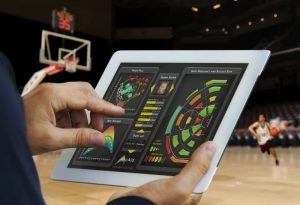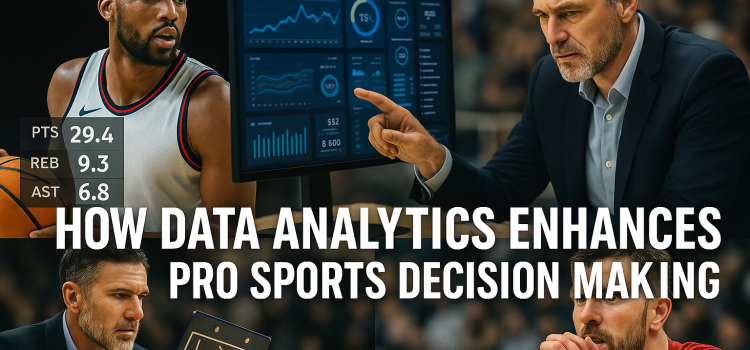
Introduction
Teams in professional sports no longer rely on gut feelings alone. Data analytics gives coaches and managers clear insights to guide decisions. From scouting new talent to planning game tactics, analytics drives better outcomes. Fans see stats on their phones, but behind the scenes teams collect massive data on player movement, health, and performance. In 2025, advanced tools let clubs spot patterns, predict injuries, and optimize training. In this article, we explain how data analytics enhances pro sports decision making. We cover types of analytics, key data sources, real-world use cases, and tips for teams. You’ll learn how analytics turns numbers into wins and keeps players at their peak.
What Is Data Analytics in Sports?
Data analytics in sports means gathering and studying numbers to find useful insights. Teams track stats like speed, distance run, heart rate, and more. They use software to turn raw data into useful reports and visual charts. These reports help answer questions: Which player fits our style? How can we reduce injuries? What tactics work best against a tough opponent? Analytics supports decisions at every level, from front-office trades to in-game coaching moves.
Types of Analytics
Analytics falls into three main types. Descriptive analytics shows what happened. For example, how many goals a player scored or how far they ran. Predictive analytics uses past data to forecast future outcomes, such as injury risk or win probability. Prescriptive analytics suggests actions, like changing training load or shifting tactics mid-game. Each type builds on the last, giving teams a full decision-making toolkit.
Why It Matters
In a sport where one play can decide a season, small edges count. Data analytics helps identify those edges. Teams save money by signing cost-effective talent. Coaches win more games by choosing better lineups. Medical staff prevent injuries by spotting fatigue early. Analytics brings objectivity and consistency to decisions that once relied on hunches.
Key Data Sources for Sports Analytics

To fuel analysis, teams gather data from many places. Each source adds a piece to the performance puzzle.
Wearable Sensors
Players wear GPS trackers, heart rate monitors, and inertial sensors in training and games. These devices measure speed, distance, acceleration, and workload. Coaches use this data to track fitness and prevent overtraining. When a player’s workload spikes too fast, the risk of injury rises. Wearable data helps staff adjust practice loads and rest days.
Video Tracking Systems
High-speed cameras line stadiums to record every movement on the field. Video analytics software uses computer vision to track player position and ball movement. Analysts study heat maps, passing networks, and defensive spacing. This helps coaches plan tactics and scout opponents by seeing how they move in different formations.
Biometric and Health Data
Smart clothing and contactless sensors record heart rate variability, sleep quality, and stress levels. When biometric data shows poor recovery, medical teams step in with extra rest or therapy. Tracking nutrition, hydration, and blood markers also guides individualized meal plans to boost performance.
Training and Performance Logs
Teams maintain digital logs of every practice drill, weight session, and rehab exercise. Players rate perceived exertion each day. Combining these logs with sensor data creates a full picture of training load. Analytics uncovers patterns that link specific drills to on-field success or injury.
External Data Sources
Weather, travel schedules, and even social media sentiment can affect performance. Analytics platforms pull in data on air quality, flight delays, and fan reactions. This info helps teams adjust travel plans and manage player morale before critical games.
How Analytics Guides Player Recruitment

Choosing the right players is the cornerstone of success. Analytics has changed scouting from simply watching highlight reels to deep data dives.
Identifying Undervalued Talent
Small-market teams use analytics to find hidden gems in lower leagues. They look at metrics like expected goals, progressive carries, or target defensive actions. A player with modest traditional stats but strong analytics scores may fit a team’s style and budget better than a star with lofty salary demands.
Fit to Tactical System
Beyond raw ability, teams analyze how a player’s actions match the coach’s tactics. For example, a center back in soccer might excel at long passes if a team plays from the back. Analysts compare player profiles to ideal roles to find the best fit.
Reducing Transfer Risk
Transfers cost millions, and signings don’t always pan out. Predictive models estimate injury risk, adaptation time, and future performance drop-off. This reduces financial risk and improves roster planning.
Analytics in Game Strategy and Tactics

Data drives choices from starting lineups to in-game substitutions.
Pre-Match Preparation
Analysts create reports on opponents’ strengths and weaknesses. They study set-piece success rates, zone entry patterns, and turnover hotspots. Coaches use this info to tailor training and set up the team to exploit gaps on game day.
Real-Time Insights
During matches, analytics platforms crunch live data. Staff monitor metrics like player fatigue, sprint counts, and opponent tactics. If a key player’s speed drops, a timely substitute can keep intensity high. Some teams use tablets on the sidelines to show formations or call for tactical tweaks.
Post-Match Review
After the game, analytics packages provide performance grades on each player and tactic. Coaches review sequences that led to goals against or for. This speeds learning and continuous improvement.
Injury Prevention and Player Health

Keeping players on the field is crucial. Analytics supports medical and sports science teams.
Load Management
Tracking training and match load helps avoid spikes that lead to soft-tissue injuries. Analytics models recommend rest days or light sessions when risk rises.
Early Injury Detection
Machine learning flags unusual movement patterns before pain starts. Wearable data may show reduced joint range or imbalanced muscle activation. Early alerts let staff intervene with physio or therapy.
Rehabilitation Tracking
Return-to-play decisions use metrics to compare rehab progress to baseline health data. This objective view reduces re-injury risk and ensures full recovery.
Business and Fan Engagement Decisions
Analytics extends beyond the pitch to run clubs more efficiently.
Ticket Pricing and Sales
Teams use dynamic pricing models like airlines. Demand data, opponent strength, and weather forecasts set ticket prices to maximize revenue and attendance.
Merchandise and Sponsorship
Sales data reveals popular player jerseys and club items. Marketing teams tailor campaigns to fan preferences. Sponsors get audience metrics to measure ROI and decide renewals.
Fan Experience Optimization
Stadium apps track concession wait times and seat movements via Wi-Fi or Bluetooth beacons. Analytics helps improve concession layouts and reduce queues. Fans get a smoother game-day experience.
Table: Analytics Applications in Pro Sports
| Use Case | Data Source | Analytics Type | Benefit |
|---|---|---|---|
| Player Recruitment | Video, performance logs | Predictive, prescriptive | Better fit, reduced risk |
| Game Strategy | Live tracking | Descriptive, predictive | In-game tactical tweaks |
| Injury Prevention | Wearables, health data | Predictive | Fewer injuries, faster return |
| Ticket Sales | Historical sales, demand | Predictive, prescriptive | Optimized pricing, attendance |
| Fan Engagement | App usage, beacon data | Descriptive | Better stadium experience |
Tips for Teams Adopting Analytics
Start with clear questions: What problem are you solving?
Build a clean data pipeline to collect reliable info.
Combine data sources for full context, like pairing heart rate with GPS.
Invest in easy-to-use dashboards so coaches and staff can access insights quickly.
Train staff on basic analytics to drive buy-in and proper use.
Iterate: test small, measure impact, refine models, and expand use cases.
Future Trends in Sports Analytics

Looking ahead, these trends will shape decisions.
AI-Driven Video Analysis
Deep learning will track body posture and predict fatigue or injury from video alone, without wearables.
Personalized Athlete Avatars
Virtual models will simulate training loads and tactics for each player, letting teams test strategies in a digital twin of their squad.
Blockchain for Data Security
Secure, decentralized storage of sensitive performance and health data will protect privacy and ensure data integrity.
Conclusion
Data analytics changes how pro sports teams make decisions. From finding hidden talent to fine-tuning tactics and preventing injuries, analytics adds clarity and objectivity. Teams that adopt analytics see better results on the field and in the business. As tools grow more powerful and user-friendly, even smaller clubs can benefit. Future innovations like AI video analysis and digital twins will deepen insights. By starting small, building strong data pipelines, and focusing on clear goals, teams can harness analytics to win more games and engage fans.
Call-to-Action
Want to boost your team’s performance with data? Explore analytics platforms today and start turning stats into wins!










